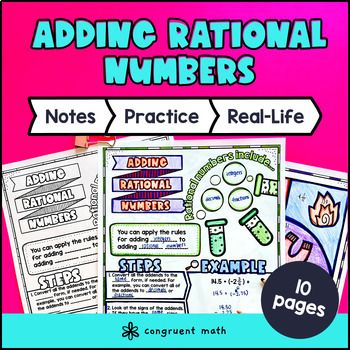Want more ideas and freebies?
Get my free resource library with digital & print activities—plus tips over email.
Join for Free Resources →
$4.25
Ever wondered how to teach adding rational numbers in an engaging way to your 7th-grade students?
In this lesson plan, students will learn about adding rational numbers (negative fractions, decimals, integers) and their real-life applications. Through artistic, interactive guided notes, check for understanding, practice sheets, and a color by number activity, students will gain a comprehensive understanding of adding rational numbers.
The lesson culminates with a real-life example that explores how adding rational numbers can be used for budgeting travel expenses and balancing accounts.

$4.25
After this lesson, students will be able to:
Before this lesson, students should be familiar with:
As a hook, ask students why adding rational numbers is important in everyday life. For example, how might adding negative integers be useful when keeping track of your spending? In this lesson, we will explore the concept of adding rational numbers, including negative fractions, decimals, and integers. We will also see how adding rational numbers can be used in real-life situations, such as budgeting for travel expenses and balancing accounts.
Follow the guided notes to introduce the following: What are rational numbers, how are the rules for rational numbers related to the properties of integers, signs for rational number addition, steps to add rational numbers, and key example (pg. 1 of guided notes).
Walk through the key points of each topic and refer to the FAQ below for a walkthrough on this, as well as ideas on how to respond to common student questions. On the following page, students will have the opportunity to practice with different types of rational numbers, including fractions, integers, and decimals (pg. 2 of guided notes). Call on students to talk through their answers, potentially on the whiteboard or projector. Based on student responses, reteach concepts that students need extra help with.
Have students practice adding rational numbers using the Integers Decimals Fractions Sheet. Walk around to answer student questions.
Fast finishers can dive into the practice sheet with problems instead of individual bubbles (pg. 3 of guided notes) or color by number (pg. 4 of guided notes) for extra practice. You can assign it as homework for the remainder of the class.
Bring the class back together, and introduce the concept of budgeting for travel expenses. Explain how adding rational numbers can be used to calculate expenses and keep track of spending. Ask students to brainstorm other real-life situations where adding rational numbers might be useful, such as balancing a checkbook or calculating the total cost of items in a shopping cart. Refer to the FAQ for more ideas on how to teach it!” Stop after writing this section and do not generate the rest of the document.
If you're looking for digital practice for adding and subtracting rational numbers, try these Pixel Art activities in Google Sheets. Every answer is automatically checked, and correct answers unlock parts of a mystery picture. It's incredibly fun, and a powerful tool for differentiation.
Here are 2 activities to explore:
A fun, no-prep way to practice adding and subtracting rational numbers is Doodle & Color by Number — they’re a fresh take on color by number or color by code. It includes multiple levels levels of practice, perfect for a review day or sub plan.
Try this:
Rational numbers are numbers that can be expressed as a ratio of two integers. They can be written as fractions or decimals that either terminate or repeat.
Understanding rational numbers is important because they are used in many real-life situations, such as calculating expenses, balancing a checkbook, and measuring ingredients in a recipe.
To add rational numbers, you first need to convert all the numbers to the same form (decimals or fractions). If they are fractions, you need to convert to a common denominator before you add. If they are decimals, you line up the place values to add. Next you have to determine the sign. If the two numbers have the same sign, keep the sign. If the two numbers have different sign, keep the sign with the larger absolute value.
Yes, you can add rational numbers with different signs. When adding rational numbers with different signs, you need to subtract the smaller absolute value from the larger absolute value and keep the sign of the number with the larger absolute value.
A mixed number is a combination of a whole number and a fraction. An improper fraction is a fraction where the numerator is greater than or equal to the denominator.
Adding rational numbers can be used in a variety of real-life situations, such as budgeting for travel expenses, balancing a checkbook, and calculating the total cost of items in a shopping cart.
The CCSS standard for adding rational numbers is 7.NS.A.1.d.
Get my free resource library with digital & print activities—plus tips over email.
Join for Free Resources →